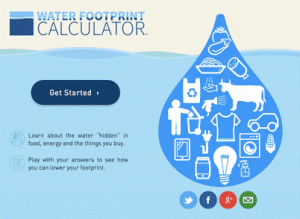
WATER FOOTPRINT CALCULATOR from GRACE Communications Foundation will help you estimate your water usage and see where most of the water is used. There are also plenty of water saving tips for around the house, food choices, shopping smarter, and even energy use.
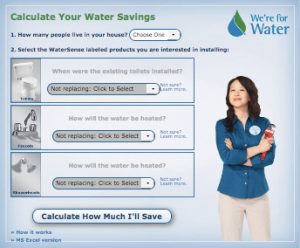
The EPA’S WATER SENSE CALCULATOR shows you how much water you can save by replacing older fixtures with newer WaterSense products. The page begins with indoor and outdoor water-saving tips – scroll down a little farther for the calculator. Click the images below the calculator for more water saving suggestions for spring, summer, fall and winter.
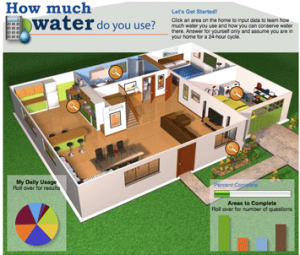
The HOME WATER WORKS CALCULATOR calculates water use in the bathroom, kitchen, laundry and outdoors. It comes with plenty of water conservation tips for homes and businesses. Extensive tips on landscaping and irrigation go from site preparation and assessing the current landscape to types of water-saving plants and their placement in the landscape, installation, irrigation and maintenance.
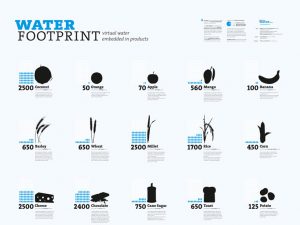
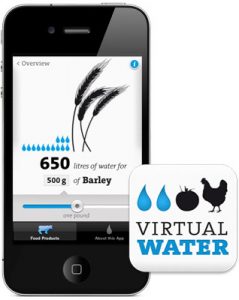
The VIRTUAL WATER PROJECTS offers a large poster (33 x 47 in., 841 x 1189 mm) showing how much water is used in the production of everyday food products, and an interactive app for iPhone showing water use for an even broader range of products.
Threats to our fresh-water resources sound dismal, but there’s good news. We can reduce consumption and make a difference using good sense, green thumbs, art and – enthusiasm! On average Africans use 5–13 gallons of water/day. Europeans use 30 gallons/day. But North Americans use up to 150 gallons /person/day. Let’s use LESS and start new habits. Please think more consciously about how you currently use water, THEN use these ideas! Download PDF
INSIDE
- Cut your shower time in half – or use low-flow showerheads
- Collect shower run-off in a bucket for your plants; and use low-flow shower heads
- Turn water off while brushing your teeth
- Run the dishwasher and washing machine only when they are full
- Fix leaks or dripping faucets which on average waste 10,000 gallons a year per household
- Don’t flush when the water is just yellow, & use dual-flush, low-flow toilets and shower heads
- Recycle shower and kitchen-sink water, etc. for lawns, gardens – and use faucet aerators
- Delay doing laundry or showering during a storm to reduce urban storm-water runoff
- Take unused medications to your town’s Alternative Medicine Cabinet for safe disposal
OUTSIDE
- Reduce use of pesticides and fertilizers (compost instead!)
- Don’t dump garbage down storm drains or in waterways
- Don’t toss cigarette butts in the street – they are non-biodegradable
- Compost leaves and yard waste
- Direct gutters and spouts away from paved surfaces to reduce runoff into storm drains
- Wash cars on unpaved ground so soap won’t flow into storm drains, and use a bucket not a hose
- Check your car for oil leaks that might wash away into waterways
- Recycle motor oil – don’t toss it!
- Clean up your pets’ waste
- Have your septic tank and septic system inspected regularly
- Plant trees and drought-tolerant, native vegetation, and rain gardens to catch roof & driveway run-off
- Use rain sensors, drip irrigation – no sprinklers; don’t overwater or water during peak use times
- Use rain barrels and use that water to wash your car and water your plants
- Sweep your sidewalks, patios and driveways, rather than hosing them down
AS A CONSUMER
- Monitor your water usage on your bill and ask your municipality for a home water audit
- Buy appliances built to conserve water and energy
- Buy a water filter if needed, not individual plastic bottles of water
AS AN ASSET MANAGER
- Contribute what you can to stewardship agencies
- Invest in green funds
GET YOUR COMMUNITY INVOLVED
- Share ways you save water – and this list! – with your neighbors and friends
- Organize and join river, pond and highway Clean-Up Days to remove trash and pollutants
- Monitor your water quality – this can be done by school groups, clubs, etc.
- Enhance access points for fishing, boating, camping, photography…
- Restore riparian areas and establish riparian buffer zones to minimize flooding
- Plan educational walks and paddle trips
- Organize a “Save our Water” concert
- Start an Alternative Medicine Cabinet in your town for safe disposal of unused medicine
USE THE PRIVILEGES OF CITIZENSHIP
- Request low-flow showerheads and toilets in public places, hotels, gyms, etc.
- In public bathrooms, use hand dryers – not paper towels (1 ton of paper consumes 17 trees)
- Ask your local water company to install differentiated pipes to return recycled water for usage in laundry – toilets – gardens – even drinking water! (Orange County, CA, did this back in 1976. Even black water can be treated to be purer than the water you are drinking now!)
- Oppose development sprawl, new highways and impermeable surfaces
- Vote for development and funding of alternative, sustainable technologies
- Support land conservation and Open Space (only 13% of Earth is protected land)
- Tell your legislators what you’re doing – and then you can ask more of them!
- Demand legal and pricing controls for water usage so agriculture will turn to more effective irrigation and more drought-tolerant crops
- Ask your elected officials to create a 5- or 10-year plan with goals to cut water and energy usage
- Support mass transportation and request no salt is used to de-ice roadways
- Vote for town plans with denser communities to be more energy efficient and share
NWNL offers this list as a helpful resource, but does not necessarily endorse the viewpoints of the videos below.
I Am Red – the Colorado River by American Rivers
Mother Nature Is Speaking by Conservation International, 2014 (1:58). We need nature, even though nature doesn’t need us!
Big Question: What is Nature Worth? by Natural Capital Project, 2010 (3:16). What biodiversity cost is really costing us.
Biodiversity 2010 by the International League of Conservation Photographers, 2010 (3:22). Fraying the fabric of flora, fauna, ecosystems and indigenous cultures.
Water-Drop at 2000 frames per second Discovery Channel’s ‘Time Warp’ series (2:30). High-speed photography explains the physics of “coalesce.”
Water 1st – Imagine by Water 1st International, 2010 (4:00). Safe water is a basic human right.
Whats’ a Watershed? by matamatamusic, 2009 (1:01). Graphics defining the concept of watershed.
Why Watersheds Matter by Hawaii Association of Watershed Partnerships, 2009 (2:39). Forested watersheds in our everyday lives.
